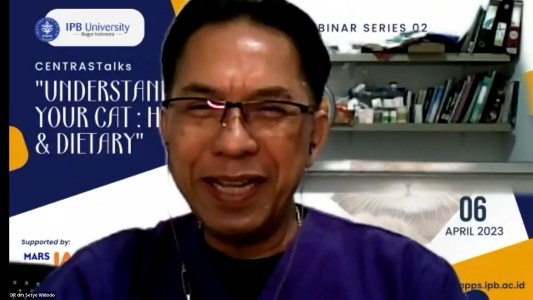Two lecturers from School of Veterinary Medicine and Biomedical Science (SKHB) IPB University explain about the diet and health of cats

Cases of obesity in domestic cats as pets are increasing. Diet or feed given in certain amounts, frequencies, and nutrients is a determining factor in cat health.
Prof Dewi Apri Astuti, IPB University lecturer from the School of Veterinary Medicine and Biomedical Science (SKHB) explained, protein and fat are the main nutrients that cats need. These nutrient requirements are affected by age, body weight, activity, species, maintenance goals and immune status.
"The higher the cat's body weight, the higher its nutritional and energy needs. Giving the amount of protein is adjusted to the body weight. Likewise, the need for fat should not be too high to avoid obesity," she explained in the 02 CentrasTalks Webinar Series 'Understanding Your Cat: Health and Dietary' held by the Center for Tropical Animal Studies (Centras), recently.
In addition, the cat's vitamins and minerals need to be adjusted, whether the provision comes from feed or additional vitamin drugs. Therefore, said Prof Dewi, the formulation of cat feed must consider its palatability.
"Feeding management is also adjusted to ad libitum (taste), quantity restrictions based on body weight, time restrictions and based on what is preferred," she added.
Dr drh Setyo Widodo, who is also an IPB University lecturer from SKHB added, in addition to the needs of the body, cat feeding also needs to consider the peculiarities of cat metabolism. Feed is given by following the peculiarities of anatomy, metabolism and physiology.
"The need for nutrients, vitamins and minerals in cats must follow these peculiarities because feeding that does not meet their needs will result in organ damage or decreased internal organ function," he explained.
These peculiarities, said Dr Setyo, are as pure carnivores, carbohydrate metabolism, glucokinase activity in the liver and protein metabolism that requires high protein.
"There is also high hepatic enzyme activity, which is two to three times higher than dogs and a special need for four amino acids namely arginine, taurine, methionine and cystine," he explained. (IAAS/MKY)



